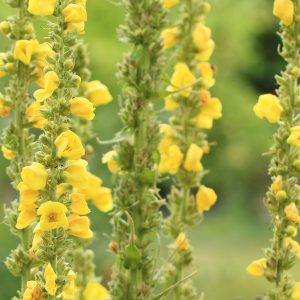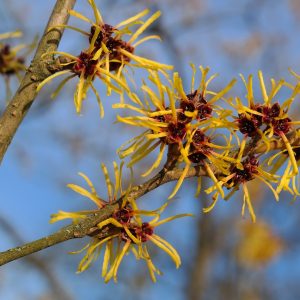
We’ve had a few blasts of on-coming winter in the past couple of weeks leaving a decidedly autumnal tinge in the air but still summer clings on and we’re able to gather ripening fruit on sunny days. There’s nothing quite like sitting outdoors stoning plums or coring apples in an effort to preserve the year’s harvest. While you’re making the most of the last of this year’s T-shirt weather, gather yourself a few herbal handfuls to help you prepare for winter. Here are 5 you can look out for this September:
CALENDULA

The name calendula is linked to the habit of this plant being in flower on the first day of every month in the calendar. That’s requires milder weather than we typically have, but it’s not unusual to be picking the bright gold and orange flowers from spring through autumn in the UK. You can use them right away or, better still, dry them for use through the winter.
Dried calendula flowers would be popped into whatever stew or broth was cooking on the stove during winter as much needed source of vitamins and guard against ill health, that’s how they gained the common name of Pot Marigold.
Now we value calendula more for its skincare properties as it’s reliably effective on even sensitive skin. Calendula can help with dry or sunburnt skin, with eczema and athelete’s foot, warts and acne. It’s gentle enough to use on young or damaged skin and will be softening and conditioning. Oily skin can be helped by calendula’s ability to clear and cleanse and the golden petals can also be used to dye hair.
Calendula is a popular herb to macerate for creating a healing oil that can be used on its own or in creams and lotions. The flowers can also be infused in water or added to facial steams and baths. A juice from the flowers can be effective in reducing scarring.
There are many recipes that include calendula in the ‘award winning’ Vital Skincare, including details on how to make your own calendula oil. Calendula is one of the herbs included in our Summer Garden Hands on Herbs box – ready to use in your own skincare blending.
HORSECHESTNUT
Seeing the spiny cases of horsechestnuts splitting open to scatter their shiny brown seeds over the ground is a sure sign that term has started and playground games can begin again. Believe me, conkers are worth fighting for! When you’ve got your stash, you’ll need to work to reveal the white flesh inside but this is what you want to chop up and macerate to create your own horse chestnut seed oil.
Why bother? Because horsechestnut seed oil is a wonderful ingredient to use on its own or to combine in creams and balms. Over the years it’s been relied upon to treat sports injuries like sprains and bring down swelling. This is due to the aescin it contains, a complex bundle of anti-inflammatory saponins. It’s also good to treat varicose veins and bruises.
Horse chestnut seed oil is one of the ‘magic’ ingredients in Field Fresh Skincare’s award-winning Kiss It Better Cream, a must for treating bumps, bruises, itches and bites.
And, if you’d prefer pre-chopped horse chestnut seed, ready to macerate, that’s included in the Summer Wild Herbs Hands on Herbs box – we try to make it easy for you 🙂
MULLEIN
If you’ve a baking hot patch in your garden, you may have found rosettes of velvety soft grey-green leaves spontaneously appearing. At this time of the year my greenhouse will typically have some huge examples. This is mullein (officially known as Verbascum Thapsus). As well as sprouting up in your garden, you’ll also find mullein in fields and along roads.
In its first year it stays close to the ground mustering strength ready to send up tall flower spikes the following summer. Both the leaves and the yellow flowers that cluster up these spikes can be used in skincare.
Mullein softens and soothes the skin, its sumptuously soft leaves giving a clue to the benefits it brings. I like to macerate dried mullein to create mullein oil, one of the oils I consider to be a ‘hard working oil’ good for use on rough or dry skin to help smooth and soothe.
When I’m making herbal macerations my rule of thumb is 3:10 for the ratio of herb to oil. However, as with all things blend-it-yourself, this is only guidance. Each herb has its own properties and best methods. In the case of mullein, that ratio needs significant revision because it is such a light and absorbent herb. Making mullein oil requires care and patience, all worth it for a really useful skincare oil. And it’s also considered a handy treatment to dab on in combatting earache.
HOUSELEEK
Every time Bob Flowerdew mentions sempervivums on Gardeners’ Question Time I’m cheering – one day I might actually send the GQT postbag a missive about using sempervivums, or houseleeks as they’re commonly known, in skincare. I’m not sure whether Bob would be in to blend-it-yourself but I reckon he’d agree with me that sempervivums are a great alternative to aloe vera, all the better for being perfectly happy growing in our climate.
The special part is the gel-like substance within their leaves which can be released with some gentle crushing in a pestle and mortar ready to include in recipes such as a light eye cream, shaving gel, hand sanitiser, deodorant, and many more. In all these it is soothing, refreshing and moisturising.
Just like Bob, I’m a great fan of houseleeks, and have pots and pipes filled with the spikey florets. This summer’s heat has produced some fantastic flowers from them too. For much more about the benefits and history of houseleeks take a look at this blog and as a starter in using houseleeks in skincare here’s 10 great recipes to try.
WITCH HAZEL
Many a bathroom cabinet will have a bottle of witch hazel in it and you’ll often find it as an ingredient in commercial cleansers, wipes and toners, especially those targeting acne and oily skin.
This ingredient is a distillation of the plant witch hazel, Hamamelis virginia. The twigs are used to produce the distillate which is recognisable for its cutting aroma.
Witch hazel is astringent, great for oily skin but possibly a little too drying for really dry skin. If your skin is dry it’s a good idea to combine witch hazel with a flower water such as rose water, lavender water or elderflower water.
A distillation of witch hazel can be used in many ways in skincare. Neat it can be swept across the face as a cleanser or toner; it’s also great to dab on after shaving to protect and freshen skin. You’ll also find witch hazel included in recipes for toners and lotions, like blackberry and honeysuckle lotion, featured in Vital Skincare.

LIKE THE IDEA OF GATHERING YOUR OWN SKINCARE INGREDIENTS? …
… you might like to read some more.
For everything you need to know to get started with Blend-it-Yourself skincare using the plants that grow around you, see Vital Skincare by Laura Pardoe. This book takes you through the techniques and ingredients you’ll need to know to make your own natural skincare.





